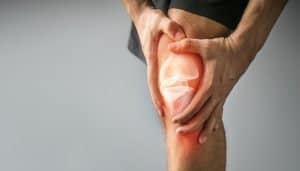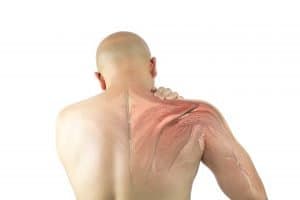Jiu Jitsu is a full contact sport and even though statistically the risk of injuries in BJJ are lower than other martial arts, they inevitably happen. If you participate in the “gentle art” long enough you’ll probably eventually experience an injury – likely minor, but possibly major.
Depending on the severity of the injury, you may need to take time off the mats. In fact… this is the best thing you could do! Take time off and let your injuries heal! However, if you (like many of us) are going to limp back onto the mat, you might as well have some idea how to prevent these injuries from getting worse when you train.
The Most Common Jiu Jitsu Injuries
Back Injuries
Certain positions can put your back in flexion which can cause irritation and micro-injuries that may become chronic over time. The most important thing to do to prevent yourself from back injuries and in fact any type of injuries, is to check your ego give a position or tap early, otherwise the pain will give your ego a lesson. In case you do get injured, you need to know if it is a muscle or a nerve injury and make sure you are properly diagnosed and get treatment.
Back injuries should be taken seriously as they can be incredibly debilitating.
Your best bet for returning to the mats after a back injury is time and rehabilitation. When you get back on the mats make sure to take the time to properly warm up. We’re not talking a few laps around the gym and some jumping jacks! Make sure the muscles of your back are good and warm before even thinking about rolling.
If you begin to feel pain, back off the intensity. As your back heals you’ll be able to roll harder, but be gentle with yourself for the first several rolls.
Neck Injuries
Neck injuries are one of those that you may not even realize you have at first and don’t feel, but then it sticks with you for 2-3 months. A common situation is when you get your opponent in an arm bar or a triangle but the person is heavy and defends by stacking you. In these cases its tempting to hang onto the submission and try to gut it out, but the reality is you are risking serious injury. Its better to let go of the submission and work on guard recovery rather than having all of your weight smashed onto your neck.
Like back injuries, neck injuries should be taken seriously. Take time off and let yourself heal. When you return be sure warm up your neck and back before you start to roll. Cold, tight muscles are more likely to be aggravated again.
Note: Warming up is not the same as static stretching! You actually want to avoid static stretches before rolling, particularly for injured areas.
Knee Injuries
Back and neck injuries are scary, but aren’t particularly common and often happen outside of submissions. Because of this they are a bit more of an abstract danger. Knee injuries on the other hand are terrifying because we’ve all seen videos of it happening in competitions or heard stories in the gym.
Editors note: When I was 17 my partner I was rolling with hooked my leg from the bottom of side control and bridged into me hard. I heard a loud ‘pop’ and immediately sat up. My partner laid there with a tragic, knowing expression on his face. “I just blew my ACL” he said to me. Sure enough that is exactly what had happened.
The most common knee injuries are tears to the meniscus, LCL, MCL,or ACL. Generally the damage happens due to lateral forces acting on the knee (side to side instead of back to front) although when guard jumps go wrong the injury can be caused by the knee hyper extending backwards.
The heel hook is notorious for damaging the knee – partially a result of competitors throwing it on quickly, but also because the knee doesn’t have the same capacity to feel pain as other joints. In a shoulder lock you’ll feel tremendous pain before damage occurs, causing you to tap. In a heel hook, however, you’ll generally feel pressure and very little pain, and then a ligament will tear. Learn to tap to this sensation of pressure. Don’t wait for pain in your knees, the message will come too late.
Interestingly, kneebars are (anecdotally) quite safe and seem to cause very few injuries. Unlike a heel hook, knee bars result in pain before damage has occurred.

Another common source of injury to the knees is landing on the kneecap while performing wrestling shots. This can be particularly bad if you’re working on thin mats laid over concrete. Your best bet for this is to be cautious performing shots on sub-optimal flooring, or to wear volleyball style knee pads.
Knee injuries vary in severity and it isn’t uncommon to have a minor sprain to a ligament in the knee. Arguably the best course of action is to take time off until it is fully healed, but if you talk to anyone who has trained for a long time you’ll know that this isn’t the most common course of action.
Instead, people opt for wearing knee braces which stabilize the knee and go back to training as normal. If you’re rolling no-gi, be sure to tell you partners about your knee and perhaps come to an agreement to avoid reaping and heel hooks.
One important, but often overlooked part of recovering from a knee injury is strengthening the muscles of your leg. The muscles above and below your knee are responsible for stabilizing the joint and offer considerable protection when they are strong. Even if your knee isn’t injured it is a good idea to keep these muscles toned.
Shoulder Injuries
Most likely these injuries occur from shoulder locks, or falling on the shoulder. If something like muscle strain happens, the shoulder treated with plenty of rest and later rehabilitative exercise. If a dislocation happens, you should consult a doctor familiar with sports medicine before returning to the mats.
Note: All shoulder dislocations are severe and should be taken seriously. When the shoulder dislocates and then pops back into place the force of it returning can actually break the humeral head.

The most important thing to remember when returning to the mats after a shoulder injury is to strengthen the joint. If the joint is still very weak you are taking a major risk getting back on the mats.
Controlled Articular Rotations (CARs) are a great way to rebuild range of motion in the shoulder (as well as other joints).
In addition to getting your range of motion back, be sure to do exercises to strengthen the muscles of the shoulder. Unlike your elbow or even your knees, the shoulder is held together almost entirely by muscles. There is very little structural support, and as such weak muscles means a weak joint.
Cauliflower Ear
There are few sports that can cause this injury to your ears. Outside of BJJ wrestling, rugby, MMA, and boxing are the most likely culprits.
Cauliflower ear is caused when the ear receives trauma which causes internal bleeding in the ear tissue. From the outside your ear looks swollen and will be extremely tender to the touch. Even resting your head on a pillow to sleep will likely be agonizingly painful.
If it is not drained promptly, your body will forms scar tissue as it heals, resulting the a permanent deformation called cauliflower ear. It is best to have your ear drained by a professional in a sterile environment. Doing it after class while you’re still covered in 10 people’s sweat is a recipe for a huge infection and is not recommended!!
After your ear is drained you’ll need to apply compression to it in order to prevent the ear from filling back up with fluid. Take at least 1 week off and use headgear when you return to training. Only after the ear is fully healed and has been pain and swelling free for a week can you return to rolling without headgear.
To avoid cauliflower ear in the first place, be careful ripping your head out of triangle chokes and don’t be afraid to tap to extreme ear discomfort in the gym. Unless you’re competing for money its not worth it getting cauliflower ear because you had too much pride to tap.

Evan is nomadic brown belt, currently living in Germany. He enjoys pressure passes and tacos.
